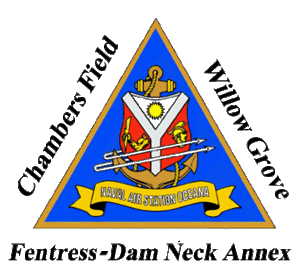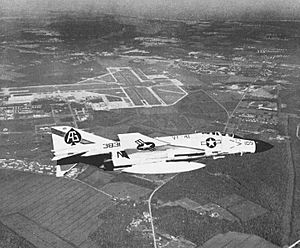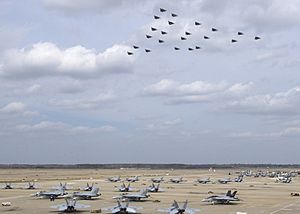Naval Air Station Oceana facts for kids
Quick facts for kids
Naval Air Station Oceana
Apollo Soucek Field
|
|||||||||||||||||||||||
|---|---|---|---|---|---|---|---|---|---|---|---|---|---|---|---|---|---|---|---|---|---|---|---|
 |
|||||||||||||||||||||||
| Summary | |||||||||||||||||||||||
| Airport type | Naval Air Station | ||||||||||||||||||||||
| Operator | United States Navy | ||||||||||||||||||||||
| Location | Virginia Beach, Virginia | ||||||||||||||||||||||
| Built | 1943 | ||||||||||||||||||||||
| In use | Active | ||||||||||||||||||||||
| Commander | CAPT Markham K. Rich | ||||||||||||||||||||||
| Coordinates | 36°49′14″N 76°02′00″W / 36.82056°N 76.03333°W | ||||||||||||||||||||||
| Runway | |||||||||||||||||||||||
|
|||||||||||||||||||||||
Naval Air Station Oceana or NAS Oceana (IATA: NTU, ICAO: KNTU, FAA LID: NTU) is a big military airport in Virginia Beach, Virginia. It's a special kind of base for the United States Navy called a "Master Jet Base." This means it's a main home for many of the Navy's jet planes.
The base is also known as Apollo Soucek Field. It was named after Lieutenant (who later became an Admiral) Apollo Soucek. He was a Navy test pilot who set a world altitude record in 1930. Soucek flew a Curtiss "Hawk" biplane to an amazing height of 43,166 feet (about 13,157 meters). NAS Oceana is the only Master Jet Base on the East Coast.
Contents
History of NAS Oceana: A Master Jet Base
How NAS Oceana Started (1940s)
The U.S. Navy bought the land for Naval Air Station Oceana in 1940. This area was mostly farmland and often flooded. It was a good spot for a second airfield to help the growing Naval Air Force at NAS Norfolk. It also allowed Navy units to get ready for deployments away from the busy Norfolk base.
NAS Norfolk had problems with its airspace, which it shared with the Norfolk International Airport. This made it hard for tactical air units (planes used for fighting) to be based there.
Becoming a Master Jet Base (1950s)
In the 1950s, NAS Oceana was made much larger. It was given the special title of "Master Jet Base." This meant it would be the main home for the Navy's tactical air units. Today, NAS Oceana is one of the largest air stations in the world. It covers about 6,820 acres (27.6 km2).
The Navy also cleared an extra 3,680 acres (14.9 km2) around the base. This helped remove obstructions and made it easier and safer for planes to fly.
Runways and Main Mission
NAS Oceana has four runways. They are set up in two pairs that form a cross shape. Three of the runways are 8,000 feet (2,438 m) long. The fourth is 12,000 feet (3,658 m) long. These runways are built for high-performance aircraft.
The main job of NAS Oceana is to train and house the Navy's Atlantic Fleet strike fighter squadrons. These squadrons fly F/A-18 Hornets and Super Hornets. Naval Aviators (pilots) and Naval Flight Officers at NAS Oceana fly about 219,000 training missions every year!
Changes in Aircraft Types
On a Navy Master Jet Base, planes are usually of the same type. This helps with maintenance and training. For a long time, NAS Oceana had two main types of aircraft: fighters and attack planes.
- F-4 Phantom II: In the 1960s, NAS Oceana became home to all East Coast F-4 Phantom II squadrons. A special unit, Fighter Squadron 101 (VF-101), was created here. It was a "Fleet Readiness Squadron" (FRS). This unit trained pilots, other crew members, and people who repaired the Phantom jets.
- F-14 Tomcat: When the F-14 Tomcat started being used in 1976, VF-101 switched to training people for the Tomcats. Phantom training then moved to Fighter Squadron 171 (VF-171). The F-4 Phantom was no longer used by the Navy in 1984. The last F-14 was retired on September 22, 2006.
- A-6 Intruder: At one time, all the Atlantic Fleet's A-6 Intruder attack squadrons were also based at NAS Oceana. Attack Squadron 42 (VA-42) was the FRS for the A-6. It trained all East Coast A-6 pilots, bomb/navigators, and maintenance personnel. The A-6E was no longer used in the Fleet in 1997.
- F/A-18 Hornet: NAS Oceana became home to the F/A-18 Hornet in 1999. This happened after NAS Cecil Field, Florida, was closed.
Current Operations at NAS Oceana
Today, NAS Oceana is home to seventeen strike fighter squadrons. These squadrons fly F/A-18 Hornets and F/A-18 Super Hornets. As the only East Coast Master Jet Base, it hosts almost all the East Coast strike-fighter (VFA) units. The main training unit, VFA-106 "Gladiators," trains pilots for both F/A-18C/D Hornets and F/A-18E/F Super Hornets.
Remembering the F-14 Tomcat
The "Tomcat Sunset" reunion was held at NAS Oceana from September 21-23, 2006. Over 3,000 former and current aircrew and maintenance workers gathered. They celebrated the retirement of the F-14 from active use. NAS Oceana was where the F-14 took off for its very last flight. An F-14D, Bureau Number 164603, flew from NAS Oceana to Calverton, Long Island, NY. It is now on display at the Northrop Grumman facilities where the Tomcat was first built.
Keeping NAS Oceana Open
During the 2005 BRAC base closures, it was decided that NAS Oceana could stay open. But there were some conditions. The biggest challenge was that the city of Virginia Beach had to buy and remove about 3,400 houses and many businesses near the base. These buildings were in the "Crash zone." This is an area where an accident is most likely to happen during landing.
If Virginia Beach could not meet these conditions, the fighter jets might have moved to NAS Cecil Field near Jacksonville, Florida. However, the Navy decided it did not want to move the Master Jet Base. On December 20, 2005, Virginia Beach passed new ordinances to meet the BRAC requirements. They did not have to destroy any homes.
NAS Oceana has also been a possible landing site for NASA's Space Shuttle if an emergency landing was ever needed.
Other Important Commands at Oceana
Besides the fighter squadrons, many other important commands are at NAS Oceana:
- Fleet Readiness Center (FRC) Mid-Atlantic: This center provides maintenance for naval aviation (planes). It helps keep the squadrons' aircraft in good shape. It also sends technicians to aircraft carriers on the East Coast when they are deployed.
- Strike Fighter Wing Atlantic: This command is in charge of all East Coast Hornet and Super Hornet squadrons. This is when they are not deployed with their carrier air wings.
- Strike Fighter Weapons School, Atlantic (SFWSL): This is a special Weapons School. F/A-18 aircrews come here for advanced training. They learn about delivering ordnance (weapons) from the air and advanced air-to-air tactics.
- Landing Signal Officer School (LSO School): Pilots chosen to be LSOs come here. They learn how to "wave" planes aboard the "boat." This is aircrew talk for guiding planes to land on an aircraft carrier.
- CVW Commands (Carrier Air Wing Commanders): These commanders are responsible for all squadrons in an air wing. This is when they are on a carrier or getting ready for overseas deployment. Carrier Air Wings ONE, THREE, SEVEN, EIGHT, and SEVENTEEN have their headquarters at NAS Oceana.
- Strike Fighter Composite Squadron 12 (VFC-12): This is a Navy Reserve F/A-18C Hornet squadron. They help train Atlantic Fleet strike fighter squadrons by acting as enemy aircraft during training.
- Fleet Logistics Support Squadron 56 (VR-56): This is another Navy Reserve squadron. They fly C-9 Skytrain II planes and provide transportation for U.S. Navy Fleet units and shore commands.
- Fleet Area Control and Surveillance Facility Virginia Capes (FACSFAC VACAPES): This group is in charge of watching and managing sea and air traffic control in the Virginia Capes training areas. They also help with Homeland Defense.
- Construction Battalion Unit 415 (CBU 415): This is a Navy Seabee Battalion. Seabees are Navy construction workers.
- Center for Naval Aviation Technical Training Unit Oceana (CNATTU Oceana): This unit trains Navy and Marine Corps aircraft maintainers (people who fix planes) on the F/A-18.
- Marine Aviation Training Support Group 33: This is a United States Marine Corps command that helps with training.
- Medical and Dental Clinic: There is a branch Medical and Dental clinic here. It is part of Naval Medical Center Portsmouth, VA.



